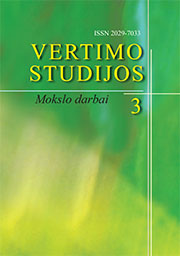TRANSLATORS’ TOOLS: LATVIAN AND LITHUANIAN BILINGUAL LEXICOGRAPHICAL
TRADITION COMPARED
TRANSLATORS’ TOOLS: LATVIAN AND LITHUANIAN BILINGUAL LEXICOGRAPHICAL
TRADITION COMPARED
Author(s): Andrejs VeisbergsSubject(s): Lexis, Comparative Linguistics, Baltic Languages, Philology, Translation Studies
Published by: Vilniaus Universiteto Leidykla
Keywords: Translation; Latvian language; Lithuanian language; Lexicographical tradition;
Summary/Abstract: Translation needs tools, the oldest and most widespread of which are (bilingual) dictionaries. In the absence of the necessary language pair dictionary, translators seek advice in foreign language dictionaries. Translators have frequently been the authors of dictionaries themselves. Latvian and Lithuanian nations and languages, though kindred, have had a rather different history. Both historically and politically, developments in Latvian have been more parallel to Estonian than Lithuanian as both fell under German and Lutheran influence while Lithuanian had a Polish-bound Catholic history. Yet the development of their writing, translation and lexicography has followed a remarkably similar process and testifies to the common space of knowledge (Wissensraum). As with their lexicography, their bilingual dictionaries grew out of a connection between translation and religion. Both countries underwent a national awakening/awareness in the 19th century that led to a greater variety of translations and dictionaries. Notably, monolingual Latvian and Lithuanian dictionaries appeared only in the 20th century, testifying to the importance of bilingual lexicography in ensuring language contact. Bilingual dictionaries have dominated the lexicography scene of Latvia and Lithuania from the start until the present day. The twentieth century, with its expanding translation needs, produced an even greater variety of translations and bilingual dictionaries in both countries.
Journal: Vertimo studijos
- Issue Year: 3/2010
- Issue No: 3
- Page Range: 131-149
- Page Count: 19
- Language: English

